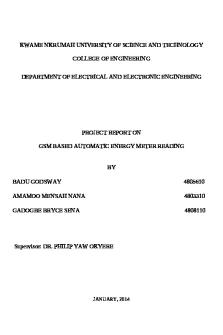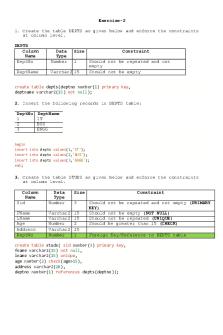Biomass Based Energy Intermediates Boosting Bio-Fuel Production-Bioboost PDF

| Title | Biomass Based Energy Intermediates Boosting Bio-Fuel Production-Bioboost |
|---|---|
| Author | Rafal Pudelko |
| Pages | 2 |
| File Size | 1.9 MB |
| File Type | |
| Total Downloads | 118 |
| Total Views | 257 |
Summary
BIOMASS BASED ENERGY INTERMEDIATES BOOSTING BIO-FUEL PRODUCTION Klaus Lenz, SYNCOM Forschungs- und Entwicklungsberatung GmbH and BioBoost consortium, www.bioboost.eu Facts Project structure Timetable THEME ENERGY.2011.3.7-1: Development of new or improved sustainable bio-energy carriers Project Refe...
Description
Accelerat ing t he world's research.
Biomass Based Energy Intermediates Boosting Bio-Fuel ProductionBioboost Rafal Pudelko
Related papers
Download a PDF Pack of t he best relat ed papers
T he Logist ics of Bioenergy Rout es for Heat and Power Ant onio Pant aleo
Current st at us and fut ure perspect ives for energy product ion from solid biomass in t he European ind… Ricardo Nepomuceno Pereira Product charact erizat ion from cat alyt ic liquefact ion of empt y palm fruit bunch (EPFB) in near and su… ramli mat
BIOMASS BASED ENERGY INTERMEDIATES BOOSTING BIO-FUEL PRODUCTION Klaus Lenz, SYNCOM Forschungs- und Entwicklungsberatung GmbH and BioBoost consortium, www.bioboost.eu
Facts
Project structure
Timetable
THEME ENERGY.2011.3.7-1: Development of new or improved sustainable bio-energy carriers Project Reference: 282873 CP in FP7 Coordinator: Karlsruher Institut für Technologie (KIT) Start: 01/2012 Duration: 42 month Budget: 7.3 Mio € Funding: 5.1 Mio € Beneficiaries: CERTH, AVACO2, CHIMAR, ENBW, TNO, GRACE, IUNG, FHOÖ, NESTE, SYNCOM, DSM, USTUTT
Objectives Objectives BioBoost paves the way for de-central conversion of biomass to optimised, high energy density carriers, which can be utilised in large scale applications for the synthesis of transportation fuel and chemicals or directly in small-scale combined heat and power (CHP) plants. The conversion of dry and wet residual biomass and wastes to an intermediate energy carriers like oil, coal or slurry is studied by: • • •
fast pyrolysis, catalytic pyrolysis, hydrothermal carbonization
Major activities include the: • analysis of the economic efficiency of the complete production pathways, • the optimization of the logistic chains and the investigation of the environmental compatibility.
Approach •
Investigate feedstock potential, costs and logistic of residual biomass in EU-28 and build-up a GEO-portal to present and display the GIS data
•
Identify an optimized energy carrier(s) produced by de-central conversion by fast pyrolysis, catalytic pyrolysis or hydrothermal carbonisation.
•
Increase feedstock flexibility of applications by optimised energy carrier(s) and investigate chemical byproducts of conversion.
•
Develop a logistic model to identify most suitable plant locations based on supply and demand.
•
Perform a technical, economical, environmental and social assessment of the chains, sensitivity and scenario analysis and LCA.
•
Investigate and demonstrate energy carrier(s) application in CHP, gasification, refinery and chemistry
First results: Straw potential
LOGISTIC model
(Institute of Soil Science and Plant Cultivation, PL)
(University of Applied Sciences, Upper Austria, FH OÖ)
Straw cost (SYNCOM)
CONCLUSION:
Calculation: Baler fix: € 4.2/t Baler var.: € 5.0/t Fuel : €1.9/t Tractor: € 57/h Labour: € 13/h Total: € 13.9/t @ 50 bales/h; i.e. 5t/ha, >10 ha or several in small distance
The de-centralized pretreatment of residues and wastes into energy carriers increases feedstock flexibility and resource efficiency.
POSTER PRESENTATION 21th European Biomass Conference, 3-7. June 2013, Copenhagen, Denmark...
Similar Free PDFs

Biomass energy ppt
- 44 Pages

GSM Based Automatic Energy Meter
- 81 Pages

Biomass exam questions
- 3 Pages

Biofuel Enzyme Background Reading
- 14 Pages

Bio3 Lab 2 guidelines Biofuel
- 15 Pages

Lecture notes on Boosting
- 11 Pages

Energy
- 5 Pages

Rule based vs Principle based
- 2 Pages

Pwc energy
- 68 Pages
Popular Institutions
- Tinajero National High School - Annex
- Politeknik Caltex Riau
- Yokohama City University
- SGT University
- University of Al-Qadisiyah
- Divine Word College of Vigan
- Techniek College Rotterdam
- Universidade de Santiago
- Universiti Teknologi MARA Cawangan Johor Kampus Pasir Gudang
- Poltekkes Kemenkes Yogyakarta
- Baguio City National High School
- Colegio san marcos
- preparatoria uno
- Centro de Bachillerato Tecnológico Industrial y de Servicios No. 107
- Dalian Maritime University
- Quang Trung Secondary School
- Colegio Tecnológico en Informática
- Corporación Regional de Educación Superior
- Grupo CEDVA
- Dar Al Uloom University
- Centro de Estudios Preuniversitarios de la Universidad Nacional de Ingeniería
- 上智大学
- Aakash International School, Nuna Majara
- San Felipe Neri Catholic School
- Kang Chiao International School - New Taipei City
- Misamis Occidental National High School
- Institución Educativa Escuela Normal Juan Ladrilleros
- Kolehiyo ng Pantukan
- Batanes State College
- Instituto Continental
- Sekolah Menengah Kejuruan Kesehatan Kaltara (Tarakan)
- Colegio de La Inmaculada Concepcion - Cebu






